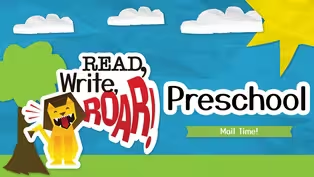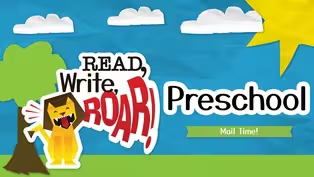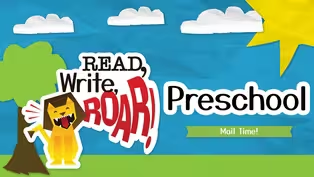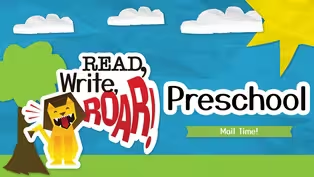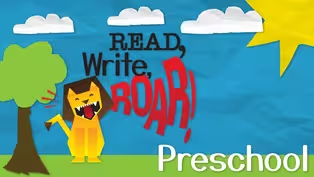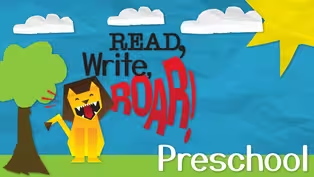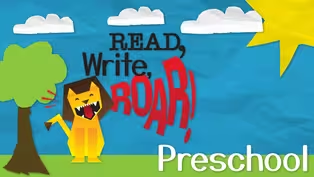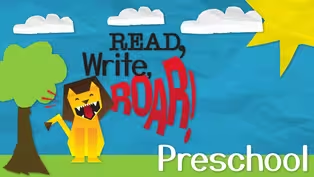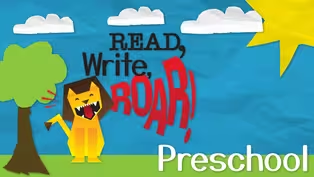Read, Write, ROAR!
Funny Faces from the Garden
Season 1 Episode 6 | 13m 19sVideo has Closed Captions
Make a fun recipe and listen to a story about gardening.
Follow a recipe to make a healthy snack with a funny face, and read a story about gardening.
Problems playing video? | Closed Captioning Feedback
Problems playing video? | Closed Captioning Feedback
Read, Write, ROAR! is a local public television program presented by Detroit PBS
Read, Write, ROAR!
Funny Faces from the Garden
Season 1 Episode 6 | 13m 19sVideo has Closed Captions
Follow a recipe to make a healthy snack with a funny face, and read a story about gardening.
Problems playing video? | Closed Captioning Feedback
How to Watch Read, Write, ROAR!
Read, Write, ROAR! is available to stream on pbs.org and the free PBS App, available on iPhone, Apple TV, Android TV, Android smartphones, Amazon Fire TV, Amazon Fire Tablet, Roku, Samsung Smart TV, and Vizio.
Providing Support for PBS.org
Learn Moreabout PBS online sponsorshipMore from This Collection
Video has Closed Captions
Learn all about how to write letters and the community helpers that deliver them! (13m 19s)
Video has Closed Captions
Learn all about builders and construction workers and try building on your own! (13m 19s)
Video has Closed Captions
What does a librarian do? Learn all about these important community helpers! (13m 19s)
Video has Closed Captions
Learn about the people who help feed our community – food and farm workers! (13m 19s)
Video has Closed Captions
Learn about the people who help keep our bodies health – medical helpers! (13m 19s)
Video has Closed Captions
What's it take to run a restaurant? Learn all about it as we open our own pizzeria! (13m 19s)
Video has Closed Captions
Take a trip outdoors and white about your adventure. (13m 19s)
Video has Closed Captions
Learn all about the letter /a/, how to write it and what sounds is represents. (13m 19s)
Video has Closed Captions
Practice action, or movement, words as we read the story Over and Under the Pond. (13m 19s)
Providing Support for PBS.org
Learn Moreabout PBS online sponsorship- Do you have a garden at your home?
In a park near you or even at your school?
We are gonna read a book about gardens and then make a healthy recipe together.
Let's go!
"Read, Write, Roar"!
- [Host] This program is made possible in part by the Kresge Foundation, the Lauren and Phillip Fisher Fund for Children and Education, the W.K.
Kellogg Foundation, the state of Michigan and by viewers like you.
Thank you.
(quirky upbeat music) (lion roaring) - Hello.
Welcome to "Read, Write, Roar".
Today we are going to be reading a book, Up in the Garden and Down in the Dirt by Kate Messner with art by Christopher Silas Neal.
And we have permission to read this book by Chronicle Books.
Up in the garden and down in the dirt.
Up in the garden, I stand and plan, my hands full of seeds and my head full of dreams.
Spring sun shines down to melt the sleepy snow.
Wind whistles through last year's plants and mud sucks at my rain boots.
"It's not quite time," Nana says, "down in the dirt, things need to dry out and warm up."
"What's down there?"
I ask.
What do you think's down there?
- There's probably a little thing from last, the plants they planted last time.
- Yes, there are some plants that do grow again.
What do you think is down there?
- Down there, maybe, like flowers?
- There might be flower seeds or bulbs, let's find out.
There could be lots of things down there.
Down in the dirt is a whole busy world of earthworms and insects, digging and building and stirring up soil.
They're already working down in the dirt.
You thought there might be some bugs down there.
Look at all the bugs and insects that are down in the dirt.
Up in the garden, we snap brittle stalks, scoop rustly armfuls and wheel away weeds for the chickens.
While they squabble and scratch, we spread compost over the soil.
Down in the dirt, pill bugs chew through last year's leaves.
I give a gentle poke.
They roll up tight and hide in plated suits of armor, roly-poly round.
Up in the garden, it's time to plant.
I trail a furrow with my finger and sprinkle seeds in a careful row.
"Give them a drink," Nana says.
We pat them down to snuggle in the dark, down in the dirt, a tomato hornworm rests, waiting for wings and the leaves where she'll lay her eggs.
Up in the garden, carrot plants sprout, pea blossoms bloom.
Wasps are on the prowl and honeybees visit, legs loaded with pollen, I'm noticing some other things.
- [Child] Down in the dirt.
- [Narrator] Down in the dirt, there's some carrots that are down in the dirt.
The roots are spreading out.
I weed and wilt in sun so strong, even Nana looks for shade.
Down in the dirt, earthworms tunnel deep.
I'm jealous of their cool, damp dark.
Up in the garden, rain shower.
Nana turns a hose on me.
Wee!
I hide behind cucumber vines but their leaves can't save me.
I shiver and laugh, drenched in Nana's rain.
Down in the dirt, water soaks deep, roots drink it in and a long-legged spider stilt-walks over the streams.
Up in the garden, there's so much to eat.
Ladybugs feast on aphids.
Nana crunches green beans.
I bite a ripe tomato, warm from the sun.
Juice dribbles down my chin.
Down in the dirt, a robin's beak finds a cricket, a beetle, a grub, slugs are scrumptious too.
Up in the garden we pick cukes and zucchinis, harvesting into the dark.
Bats swoop through the sunflowers and I pluck June bugs from the basil until it's time for bed.
Down in the dirt, skunks work the night shift.
They snuffle and dig and gobble worms while I sleep.
Up in the garden, a praying mantis wakes to hunt mosquitoes.
Nana sprays away the aphids and I'm after grasshoppers, ready to swoosh but snap, someone else is faster.
Down in the dirt, a smooth, shining gardener snake crunches on supper.
Up in the garden, the wind grows cool.
Pumpkins blush orange and sunflowers bow to September.
Nana ties them together to build a house for reading.
Look, she's reading the letter S. Down in the dirt, an orb weaver spins her web, strand by silken strand, she'll munch on moths tonight.
Up in the garden, colored leaves litter the squash vines and we know the cold is coming.
Hurry, hurry and harvest!
There's enough for the neighbors, too.
Down in the dirt, frantic ants gather what we leave behind.
They're storing food for cooler days ahead.
Up in the garden, frost draws lace on leftover leaves, where secret egg sacs hang, waiting for the warm to return.
We say goodbye and spread the winter blankets.
Down in the dirt, beetles burrow and scurry home.
Earthworms crawl tight in the dark.
When Grandpa calls us in for soup, an autumn moon is rising.
Up in the garden, dry corn stalks tremble and the wind smells like winter.
But the long ripe days of summer still rest in the garden beds, the lady bugs and bumblebees, earthworms and ants are hunkered down, hiding, biding their time, dreaming of sunshine and blossoms and sprouts.
Under the bare arms of trees and the blanketing snow, a whole new garden sleeps down in the dirt.
So what's happening?
- So the whole garden, they're sleeping.
- They're sleeping.
That means everything is still.
And they have to wait for what to happen before they come back out?
- Spring.
- Spring.
- And summer.
- And spring and summer.
So in this book, we learned a lot about gardens.
Tell me something you remember.
What do you remember?
- They had to grow new stuff in the garden.
- They did have to grow new things in the garden.
Do you remember something they grew?
- They grew a tomato.
- They grew a tomato.
'Cause I remember it was juicy and it dribbled down her chin, what do you remember?
- I know they was doing dreaming and also, wait for winter to stop also waiting for spring to come.
And also going to be warm and toasty and dreaming about plants.
- That's right.
- And that's all.
- When they burrowed underneath and then you remembered something Tovia.
What did you remember?
- They all had to harvest the food for the winter.
- [Narrator] Yeah, they harvested their food and they were gonna share it with the neighbors.
Thank you all for listening.
(upbeat music) Who here likes to eat?
Who here likes to make the things that they eat?
Well today, we are going to be using vegetables that could be grown in a garden to make vegetable pizza face.
And to do that, we're gonna follow a recipe.
And in a recipe there are a list of ingredients, which is the food that you might use, to create your vegetable pizza face.
So let's read what ingredients we'll have.
A tortilla, cream cheese, black olives, carrot sticks, cherry tomatoes, broccoli and celery sticks.
Step one, lay your tortilla flat.
Step two, take a spoon and get cream cheese from the container.
Step three, put the cream cheese onto your tortilla.
Step four, with the bottom of your spoon, spread the cream cheese out on your tortilla.
Now it says step five, choose your vegetables and make a face.
It can be as real-looking or as silly as you want.
Remember the ingredients are the vegetables that you have in your bowl, you can use it to now create a face.
And it could be any way you want.
- [Joshua] See the line?
My mouth would be open.
- Oh, your mouth is gonna be open?
You're using celery as the mouth of your face.
You were creative.
You came up with your own design.
You wanna see what the fourth ingredient is?
- The tomatoes are for the.
- You think it's the tomatoes?
That's like, after carrot sticks, you're right.
It says cherry tomatoes.
What might you use your cherry tomatoes for, Joshua?
- Cheeks.
- Cheeks.
What did you notice that they used their broccoli for?
- [Joshua] The nose.
- The nose.
But you might think to use your nose or your broccoli as something different.
All right and the final ingredient, I think this is the one you used first, but it says celery sticks.
- [Joshua] Celery sticks.
Gonna use mine for my eyebrows.
- [Narrator] For your eyebrows.
All right.
Tell me about what you created.
- (hesitating) My is eating, yum, yum.
- [Narrator] Oh, that's why his mouth is open 'cause he's eating.
And if he had to eat one of these vegetables as his favorite, what do you think he might eat?
- His teeth, he'll eat these.
- The shredded carrots.
That's part of my favorites.
I actually like shredded carrots on my sandwiches.
All right.
Tell me about what you created.
- I used the celery sticks for eyebrows and I use the carrots for hair.
And then I used another celery stick for the mouth.
Then I used the broccoli for the nose and the tomatoes for the cheeks.
- And the tomatoes for the cheeks, you all have lots of facial features for your vegetable face.
And what's your favorite vegetable?
- [Girl] Broccoli.
- Broccoli.
Tell me about yours.
- So the celery stick, it is in two parts, which is the ears and the mouth and the olives are for dimples and the eyes are tomatoes and the broccoli is for the nose and the carrots and cheese are for the hair.
- These look delicious.
Let's dig in.
(upbeat music) When reading, ask your child different types of questions.
Start with questions that can be found right in the book.
Then move on to questions that ask the child to summarize, or talk about the main points, of what they learned.
A summary question is a bit of a harder question for children since they have to put together all of the information from the book in order to answer it.
Asking both types of questions keeps the conversation going.
Kids love exploring literacy in the kitchen.
Practice reading and following a recipe together.
Use pretty simple ingredients, which you may already have on hand at home.
Recipes don't have to be fancy.
You can even follow one off the back of a box.
Swipe your finger under the words of a recipe while you are reading it to your child.
Follow the directions together.
Through this process, your child is learning that text is used to inform us of something.
In this case, the text is giving us information about how to do something.
With recipes, it's how to make a particular food.
Head outdoors and see if you can make a mud pie with your child, what ingredients might you use in your mud pie recipe besides dirt and water?
Sticks, leaves, rocks?
What steps might there be in a mud pie recipe?
Enjoy making this one but I wouldn't eat it.
(upbeat music) See you next time on "Read, Write, Roar".
- [Host] This program is made possible in part by the Kresge Foundation, the Lauren and Phillip Fisher Fund for Children and Education, the W.K.
Kellogg Foundation, the state of Michigan and by viewers like you.
Thank you.
(upbeat music) (upbeat music ends)


- Home and How To

Hit the road in a classic car for a tour through Great Britain with two antiques experts.












Support for PBS provided by:
Read, Write, ROAR! is a local public television program presented by Detroit PBS
